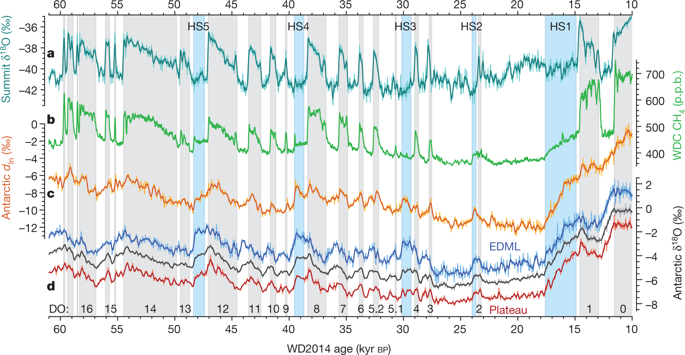Our official English website, www.x-mol.net, welcomes your feedback! (Note: you will need to create a separate account there.)
Abrupt ice-age shifts in southern westerly winds and Antarctic climate forced from the north
Nature ( IF 50.5 ) Pub Date : 2018-11-01 , DOI: 10.1038/s41586-018-0727-5 Christo Buizert , Michael Sigl , Mirko Severi , Bradley R. Markle , Justin J. Wettstein , Joseph R. McConnell , Joel B. Pedro , Harald Sodemann , Kumiko Goto-Azuma , Kenji Kawamura , Shuji Fujita , Hideaki Motoyama , Motohiro Hirabayashi , Ryu Uemura , Barbara Stenni , Frédéric Parrenin , Feng He , T. J. Fudge , Eric J. Steig
Nature ( IF 50.5 ) Pub Date : 2018-11-01 , DOI: 10.1038/s41586-018-0727-5 Christo Buizert , Michael Sigl , Mirko Severi , Bradley R. Markle , Justin J. Wettstein , Joseph R. McConnell , Joel B. Pedro , Harald Sodemann , Kumiko Goto-Azuma , Kenji Kawamura , Shuji Fujita , Hideaki Motoyama , Motohiro Hirabayashi , Ryu Uemura , Barbara Stenni , Frédéric Parrenin , Feng He , T. J. Fudge , Eric J. Steig

|
The mid-latitude westerly winds of the Southern Hemisphere play a central role in the global climate system via Southern Ocean upwelling1, carbon exchange with the deep ocean2, Agulhas leakage (transport of Indian Ocean waters into the Atlantic)3 and possibly Antarctic ice-sheet stability4. Meridional shifts of the Southern Hemisphere westerly winds have been hypothesized to occur5,6 in parallel with the well-documented shifts of the intertropical convergence zone7 in response to Dansgaard–Oeschger (DO) events— abrupt North Atlantic climate change events of the last ice age. Shifting moisture pathways to West Antarctica8 are consistent with this view but may represent a Pacific teleconnection pattern forced from the tropics9. The full response of the Southern Hemisphere atmospheric circulation to the DO cycle and its impact on Antarctic temperature remain unclear10. Here we use five ice cores synchronized via volcanic markers to show that the Antarctic temperature response to the DO cycle can be understood as the superposition of two modes: a spatially homogeneous oceanic ‘bipolar seesaw’ mode that lags behind Northern Hemisphere climate by about 200 years, and a spatially heterogeneous atmospheric mode that is synchronous with abrupt events in the Northern Hemisphere. Temperature anomalies of the atmospheric mode are similar to those associated with present-day Southern Annular Mode variability, rather than the Pacific–South American pattern. Moreover, deuterium-excess records suggest a zonally coherent migration of the Southern Hemisphere westerly winds over all ocean basins in phase with Northern Hemisphere climate. Our work provides a simple conceptual framework for understanding circum-Antarctic temperature variations forced by abrupt Northern Hemisphere climate change. We provide observational evidence of abrupt shifts in the Southern Hemisphere westerly winds, which have previously documented1–3 ramifications for global ocean circulation and atmospheric carbon dioxide. These coupled changes highlight the necessity of a global, rather than a purely North Atlantic, perspective on the DO cycle.The position of the Southern Hemisphere westerly winds responds immediately to abrupt North Atlantic climate events of the last ice age, with a spatially heterogeneous impact on Antarctic climate.
中文翻译:

南西风和南极气候的突然冰河时代转变来自北方
南半球的中纬度西风通过南大洋上升流 1、与深海的碳交换 2、厄加勒斯渗漏(将印度洋水域输送到大西洋)3 以及可能的南极冰盖,在全球气候系统中发挥着核心作用稳定性 4. 据推测,南半球西风的经向变化 5,6 与热带辐合带 7 为响应丹斯加德 - 厄施格 (DO) 事件(上一个冰河时代的突然北大西洋气候变化事件)而有充分记录的变化同时发生. 将水分路径转移到南极洲西部 8 与这种观点一致,但可能代表了热带地区强迫的太平洋遥相关模式 9。南半球大气环流对溶解氧循环的充分响应及其对南极温度的影响尚不清楚10。在这里,我们使用通过火山标记同步的五个冰芯来表明南极温度对 DO 循环的响应可以理解为两种模式的叠加:一种空间均质的海洋“双极跷跷板”模式,落后于北半球气候约 200 年,以及与北半球突发事件同步的空间异质大气模式。大气模式的温度异常类似于与当今南部环形模式变率相关的异常,而不是太平洋-南美模式。而且,氘过量记录表明,南半球西风在所有海洋盆地的纬向一致迁移与北半球气候同步。我们的工作提供了一个简单的概念框架,用于理解北半球突然气候变化造成的环南极温度变化。我们提供了南半球西风突然转变的观测证据,之前已经记录了 1-3 对全球海洋环流和大气二氧化碳的影响。这些耦合变化突出了对 DO 循环的全球视角而非纯粹的北大西洋视角的必要性。南半球西风的位置对上一个冰河时代的突然北大西洋气候事件立即做出反应,具有空间异质性影响关于南极气候。
更新日期:2018-11-01
中文翻译:

南西风和南极气候的突然冰河时代转变来自北方
南半球的中纬度西风通过南大洋上升流 1、与深海的碳交换 2、厄加勒斯渗漏(将印度洋水域输送到大西洋)3 以及可能的南极冰盖,在全球气候系统中发挥着核心作用稳定性 4. 据推测,南半球西风的经向变化 5,6 与热带辐合带 7 为响应丹斯加德 - 厄施格 (DO) 事件(上一个冰河时代的突然北大西洋气候变化事件)而有充分记录的变化同时发生. 将水分路径转移到南极洲西部 8 与这种观点一致,但可能代表了热带地区强迫的太平洋遥相关模式 9。南半球大气环流对溶解氧循环的充分响应及其对南极温度的影响尚不清楚10。在这里,我们使用通过火山标记同步的五个冰芯来表明南极温度对 DO 循环的响应可以理解为两种模式的叠加:一种空间均质的海洋“双极跷跷板”模式,落后于北半球气候约 200 年,以及与北半球突发事件同步的空间异质大气模式。大气模式的温度异常类似于与当今南部环形模式变率相关的异常,而不是太平洋-南美模式。而且,氘过量记录表明,南半球西风在所有海洋盆地的纬向一致迁移与北半球气候同步。我们的工作提供了一个简单的概念框架,用于理解北半球突然气候变化造成的环南极温度变化。我们提供了南半球西风突然转变的观测证据,之前已经记录了 1-3 对全球海洋环流和大气二氧化碳的影响。这些耦合变化突出了对 DO 循环的全球视角而非纯粹的北大西洋视角的必要性。南半球西风的位置对上一个冰河时代的突然北大西洋气候事件立即做出反应,具有空间异质性影响关于南极气候。






































 京公网安备 11010802027423号
京公网安备 11010802027423号